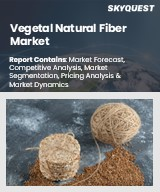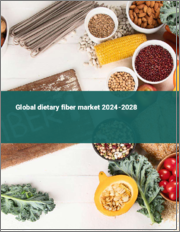
|
시장보고서
상품코드
1838287
식물성 천연섬유 시장 규모, 점유율, 성장 분석 : 섬유 유형별, 공급원별, 용도별, 지역별 예측(2025-2032년)Vegetal Natural Fiber Market Size, Share, and Growth Analysis, By Fiber Type (Cellulose, Lignin), By Source (Cotton, Flax), By Application, By Region - Industry Forecast 2025-2032 |
||||||
세계의 식물성 천연섬유 시장 규모는 2023년에 1,202억 달러로 평가되었고, 2024년 1,303억 달러에서 2032년에는 2,484억 1,000만 달러로 성장하고, 예측 기간 중(2025-2032년)의 CAGR은 8.4%를 나타낼 전망입니다.
세계의 식물성 천연섬유 시장은 지속가능한 소재와 생분해성 소재에 대한 소비자의 선호도가 높아짐에 따라 현저한 성장을 이루고 있습니다. 자동차, 건설, 포장, 섬유 등의 산업은 합성 소재에서 환경 친화적인 대체 소재로의 전환을 선호합니다. 이 변화는 대체 원료의 사용을 촉진하는 정부 이니셔티브에 의해 지원되는 바이오 경제의 성장과 일치합니다. 합성 섬유와 플라스틱이 환경에 미치는 영향에 대한 의식이 높아짐에 따라 이러한 분야에서 큰 혼란이 발생할 수 있습니다. 단열재, 보강재, 판판 등의 용도는 산업화와 그린 빌딩의 움직임으로부터 혜택을 받게 됩니다. 그러나 계절에 좌우되는 원료의 입수가능성, 가공비용의 상승, 생산품질과 일관성에 영향을 미치는 개발도상지역의 지식격차 등 과제도 남아 있습니다.
자주 묻는 질문
목차
서론
- 조사의 목적
- 조사 범위
- 정의
조사 방법
- 정보 조달
- 2차와 1차 데이터의 방법
- 시장 규모 예측
- 시장의 전제조건과 제한
주요 요약
- 세계 시장 전망
- 공급과 수요 동향 분석
- 부문별 기회 분석
시장 역학과 전망
- 시장 개요
- 시장 규모
- 시장 역학
- 성장 촉진요인과 기회
- 성장 억제요인과 과제
- Porter's Five Forces 분석
주요 시장 인사이트
- 성공 핵심 요소
- 경쟁 정도
- 주요 투자 분야
- 시장 생태계
- 시장 매력 지수(2024년)
- PESTEL 분석
- 거시경제지표
- 밸류체인 분석
- 가격 분석
식물성 천연섬유 시장 규모 : 섬유 유형별&CAGR(2025-2032년)
- 시장 개요
- 셀룰로오스
- 리그닌
- 펙틴
- 전분
- 기타 섬유 유형
식물성 천연섬유 시장 규모 : 공급원별&CAGR(2025-2032년)
- 시장 개요
- 면
- 아마
- 목재
- 대마
- 기타 공급원
식물성 천연섬유 시장 규모 : 용도별&CAGR(2025-2032년)
- 시장 개요
- 건설
- 자동차
- 섬유
- 제지 및 펄프
- 기타 용도
식물성 천연섬유 시장 규모 : 지역별&CAGR(2025-2032년)
- 북미
- 미국
- 캐나다
- 유럽
- 독일
- 스페인
- 프랑스
- 영국
- 이탈리아
- 기타 유럽
- 아시아태평양
- 중국
- 인도
- 일본
- 한국
- 기타 아시아태평양
- 라틴아메리카
- 브라질
- 기타 라틴아메리카
- 중동 및 아프리카
- GCC 국가
- 남아프리카
- 기타 중동 및 아프리카
경쟁 정보
- 상위 5개사 비교
- 주요 기업 시장 포지셔닝(2024년)
- 주요 시장 기업이 채용한 전략
- 최근 시장 동향
- 기업 시장 점유율 분석(2024년)
- 주요 기업 프로파일
- 기업 상세 정보
- 제품 포트폴리오 분석
- 기업 부문별 점유율 분석
- 연간 매출 비교(2022-2024년)
주요 기업 프로파일
- Aditya Birla Group(India)
- Bcomp Ltd.(Switzerland)
- FlexForm Technologies(USA)
- Polyvlies Franz Beyer GmbH(Germany)
- TECNARO GmbH(Germany)
- NPSP BV(Netherlands)
- Spinnova Plc(Finland)
- Ananas Anam(UK)
- Engage Group(Thailand)
- Setralit(Germany)
- HempFlax Group BV(Netherlands)
- UPM-Kymmene Corporation(Finland)
- GreenGran BN(China)
- MYNUSCo(India)
- Holland Composites(Netherlands)
- Aksa(튀르키예)
- Bast Fibre Technologies(Canada)
- Jute Corporation of India(India)
- Finisterre(UK)
- MATE the Label(USA)
결론과 권고
KTH 25.10.22Global Vegetal Natural Fiber Market size was valued at USD 120.2 billion in 2023 and is poised to grow from USD 130.3 billion in 2024 to USD 248.41 billion by 2032, growing at a CAGR of 8.4% during the forecast period (2025-2032).
The global vegetal natural fiber market is experiencing notable growth, driven by a rising consumer preference for sustainable and biodegradable materials. Industries such as automotive, construction, packaging, and textiles are prioritizing the transition from synthetic materials to eco-friendly alternatives. This shift aligns with the growing bio-based economy, supported by government initiatives promoting the use of alternative raw materials. As awareness increases regarding the environmental impacts of synthetic fibers and plastics, there is potential for significant disruption in these sectors. Applications in insulation, reinforcement, and paneling stand to benefit from industrialization and green building movements. However, challenges remain, including seasonally dependent raw material availability, higher processing costs, and knowledge gaps in developing regions that affect production quality and consistency.
Top-down and bottom-up approaches were used to estimate and validate the size of the Global Vegetal Natural Fiber market and to estimate the size of various other dependent submarkets. The research methodology used to estimate the market size includes the following details: The key players in the market were identified through secondary research, and their market shares in the respective regions were determined through primary and secondary research. This entire procedure includes the study of the annual and financial reports of the top market players and extensive interviews for key insights from industry leaders such as CEOs, VPs, directors, and marketing executives. All percentage shares split, and breakdowns were determined using secondary sources and verified through Primary sources. All possible parameters that affect the markets covered in this research study have been accounted for, viewed in extensive detail, verified through primary research, and analyzed to get the final quantitative and qualitative data.
Global Vegetal Natural Fiber Market Segments Analysis
Global Vegetal Natural Fiber Market is segmented by Fiber Type, Source, Application and region. Based on Fiber Type, the market is segmented into Cellulose, Lignin, Pectin, Starch and Other Fiber Types. Based on Source, the market is segmented into Cotton, Flax, Wood, Hemp and Other Sources. Based on Application, the market is segmented into Construction, Automotive, Textiles, Paper and Pulp and Other Applications. Based on region, the market is segmented into North America, Europe, Asia Pacific, Latin America and Middle East & Africa.
Driver of the Global Vegetal Natural Fiber Market
The rising awareness regarding the environmental consequences of plastics and synthetic fibers has significantly fueled the demand for vegetal natural fibers. These fibers, being biodegradable and renewable, align with the ongoing global sustainability movement. Various industries, including textiles, automotive, and packaging, are facing mounting pressure to transition away from conventional synthetic materials in favor of more sustainable alternatives. This shift is driven by increasing consumer preferences for eco-friendly products alongside regulatory measures encouraging the adoption of sustainable materials and practices. Consequently, there is a surge in opportunities for the integration of vegetal natural fibers across diverse sectors, promoting a more sustainable future.
Restraints in the Global Vegetal Natural Fiber Market
The Global Vegetal Natural Fiber market faces constraints due to the limited availability of vegetable fibers, which is closely tied to climate conditions and agricultural cycles. This variability in supply can significantly influence pricing and the dependability of fiber availability for various industries. Consequently, industries aiming for broader adoption may encounter challenges, especially manufacturers that depend on a consistent and stable supply to maintain efficient production processes. Such unpredictability can hinder growth and scalability, posing a significant obstacle for companies seeking to expand their operations within this market.
Market Trends of the Global Vegetal Natural Fiber Market
The Global Vegetal Natural Fiber market is experiencing significant growth, driven by an increasing demand for bio-based composites across various industries. As sectors such as automotive, packaging, and construction prioritize lightweight, sustainable, and recyclable materials, there is a marked shift from synthetic fibers to vegetal natural fibers like flax, hemp, and jute for nonwoven and composite applications. This trend is further fueled by stringent carbon emissions regulations and a consumer preference for environmentally conscious alternatives, blending the textile values of design, comfort, and performance with sustainability. As a result, the emphasis on eco-friendly solutions is reshaping market dynamics.
Table of Contents
Introduction
- Objectives of the Study
- Scope of the Report
- Definitions
Research Methodology
- Information Procurement
- Secondary & Primary Data Methods
- Market Size Estimation
- Market Assumptions & Limitations
Executive Summary
- Global Market Outlook
- Supply & Demand Trend Analysis
- Segmental Opportunity Analysis
Market Dynamics & Outlook
- Market Overview
- Market Size
- Market Dynamics
- Drivers & Opportunities
- Restraints & Challenges
- Porters Analysis
- Competitive rivalry
- Threat of substitute
- Bargaining power of buyers
- Threat of new entrants
- Bargaining power of suppliers
Key Market Insights
- Key Success Factors
- Degree of Competition
- Top Investment Pockets
- Market Ecosystem
- Market Attractiveness Index, 2024
- PESTEL Analysis
- Macro-Economic Indicators
- Value Chain Analysis
- Pricing Analysis
Global Vegetal Natural Fiber Market Size by Fiber Type & CAGR (2025-2032)
- Market Overview
- Cellulose
- Lignin
- Pectin
- Starch
- Other Fiber Types
Global Vegetal Natural Fiber Market Size by Source & CAGR (2025-2032)
- Market Overview
- Cotton
- Flax
- Wood
- Hemp
- Other Sources
Global Vegetal Natural Fiber Market Size by Application & CAGR (2025-2032)
- Market Overview
- Construction
- Automotive
- Textiles
- Paper and Pulp
- Other Applications
Global Vegetal Natural Fiber Market Size & CAGR (2025-2032)
- North America (Fiber Type, Source, Application)
- US
- Canada
- Europe (Fiber Type, Source, Application)
- Germany
- Spain
- France
- UK
- Italy
- Rest of Europe
- Asia Pacific (Fiber Type, Source, Application)
- China
- India
- Japan
- South Korea
- Rest of Asia-Pacific
- Latin America (Fiber Type, Source, Application)
- Brazil
- Rest of Latin America
- Middle East & Africa (Fiber Type, Source, Application)
- GCC Countries
- South Africa
- Rest of Middle East & Africa
Competitive Intelligence
- Top 5 Player Comparison
- Market Positioning of Key Players, 2024
- Strategies Adopted by Key Market Players
- Recent Developments in the Market
- Company Market Share Analysis, 2024
- Company Profiles of All Key Players
- Company Details
- Product Portfolio Analysis
- Company's Segmental Share Analysis
- Revenue Y-O-Y Comparison (2022-2024)
Key Company Profiles
- Aditya Birla Group (India)
- Company Overview
- Business Segment Overview
- Financial Updates
- Key Developments
- Bcomp Ltd. (Switzerland)
- Company Overview
- Business Segment Overview
- Financial Updates
- Key Developments
- FlexForm Technologies (USA)
- Company Overview
- Business Segment Overview
- Financial Updates
- Key Developments
- Polyvlies Franz Beyer GmbH (Germany)
- Company Overview
- Business Segment Overview
- Financial Updates
- Key Developments
- TECNARO GmbH (Germany)
- Company Overview
- Business Segment Overview
- Financial Updates
- Key Developments
- NPSP BV (Netherlands)
- Company Overview
- Business Segment Overview
- Financial Updates
- Key Developments
- Spinnova Plc (Finland)
- Company Overview
- Business Segment Overview
- Financial Updates
- Key Developments
- Ananas Anam (UK)
- Company Overview
- Business Segment Overview
- Financial Updates
- Key Developments
- Engage Group (Thailand)
- Company Overview
- Business Segment Overview
- Financial Updates
- Key Developments
- Setralit (Germany)
- Company Overview
- Business Segment Overview
- Financial Updates
- Key Developments
- HempFlax Group B.V. (Netherlands)
- Company Overview
- Business Segment Overview
- Financial Updates
- Key Developments
- UPM-Kymmene Corporation (Finland)
- Company Overview
- Business Segment Overview
- Financial Updates
- Key Developments
- GreenGran BN (China)
- Company Overview
- Business Segment Overview
- Financial Updates
- Key Developments
- MYNUSCo (India)
- Company Overview
- Business Segment Overview
- Financial Updates
- Key Developments
- Holland Composites (Netherlands)
- Company Overview
- Business Segment Overview
- Financial Updates
- Key Developments
- Aksa (Turkey)
- Company Overview
- Business Segment Overview
- Financial Updates
- Key Developments
- Bast Fibre Technologies (Canada)
- Company Overview
- Business Segment Overview
- Financial Updates
- Key Developments
- Jute Corporation of India (India)
- Company Overview
- Business Segment Overview
- Financial Updates
- Key Developments
- Finisterre (UK)
- Company Overview
- Business Segment Overview
- Financial Updates
- Key Developments
- MATE the Label (USA)
- Company Overview
- Business Segment Overview
- Financial Updates
- Key Developments















